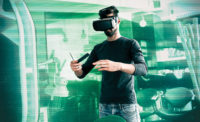Climate change, along with other factors, have led to an increase in fires. While there isn’t a direct relationship between climate change and fire, researchers at the United States Geological Survey (USGS) have found strong correlations between warmer summer temperatures and large fire years. In response, advances in technology are helping to ensure firefighters are fully equipped to quickly and safely respond to fires. Specifically, the increased use of reality capture technology to create virtual real world scenarios for firefighter training.
Reality capture is the process of collecting real-world 3D data about buildings, objects, or environments to create digital models, also known as digital twins. The key is to make the digital twins as accurate as possible.
As we know, in the world of first responders, time is everything. How quickly a fire department can get to a scene, assess the situation, plan, and act can be a matter of life and death. This makes training essential to their effectiveness – the more realistic, the better.
What the general public may not realize is that when it comes to firefighter training, it’s often conducted in homes and other buildings slated for demolition. This means there’s a limited window that they can be used – unless the structures can be captured digitally. While a city's emergency responders have floor plans and blueprints for active buildings, they often lack detailed accuracy that would be crucial in the event of a fire.
However, the right reality capture technology enables users to easily scan a building, upload the scans to the cloud to create a digital twin, and use the digital twin – a model of the real-world building – for virtual training. A company called RSET, Inc., creates virtualizations for fire, EMS, police, and military groups to conduct core skills and training, and RSET has been busy working with several fire departments across Kentucky.
According to Bill Gregory, CEO of RSET, “Many fire departments say this is exactly what we want – to be able to do virtual training in real world buildings.”
Empowering Firefighters to Create Virtual Training Modules
Creating digital twins starts with a scan. Essentially, a handheld imaging laser scanner enables professionals like Gregory to walk through a building and capture its details within minutes. From there, he can process the scans, upload them to the cloud from the field, and create digital twins of a structure while on site, using a cloud-based modeling and visualization platform. The whole process only takes a few hours and creates a digital file that can be easily revisited and shared to master the layout of the building or any other purpose a city or town may need.
For example, Kentucky fire departments in Lexington, Owensboro and Bowling Green are now using reality capture technology for firefighter training. The virtual exercises inform everything the departments do – from the placement of fire ladders to the location of the hose trucks and even how to activate key emergency staff including human resources. The digital twins of buildings are similar to video game environments, so the learning curve for trainees is very low.
“We were dressed in protective gear and used the Leica BLK2GO to walk the premises of a fire training drill site. Within 15 minutes, we had the terrain map, exteriors of the building, trees, surrounding locations and everything we needed,” Gregory said. “The firefighters would do one exercise physically while the building was still standing and then do it many times over, virtually.”
Gregory says RSET’s goals aren’t to do the scans themselves but to empower first responders to use 3D reality capture, with RSET creating the virtual training modules for them.
“I advocate for first responder teams to get their own scanners,” Gregory explained. “The technology is so easy to use. We want first responders to do their own scanning to capture everything in their own environments and then use our technology to train.”
Reality capture has become so advanced that it’s simple for anybody to quickly learn. If you’ve played first-person video games like Call of Duty, you can create a virtual training module that offers immersive digital twins for intuitive training, which ensures first responders have optimized their skills for real world life and death situations.


